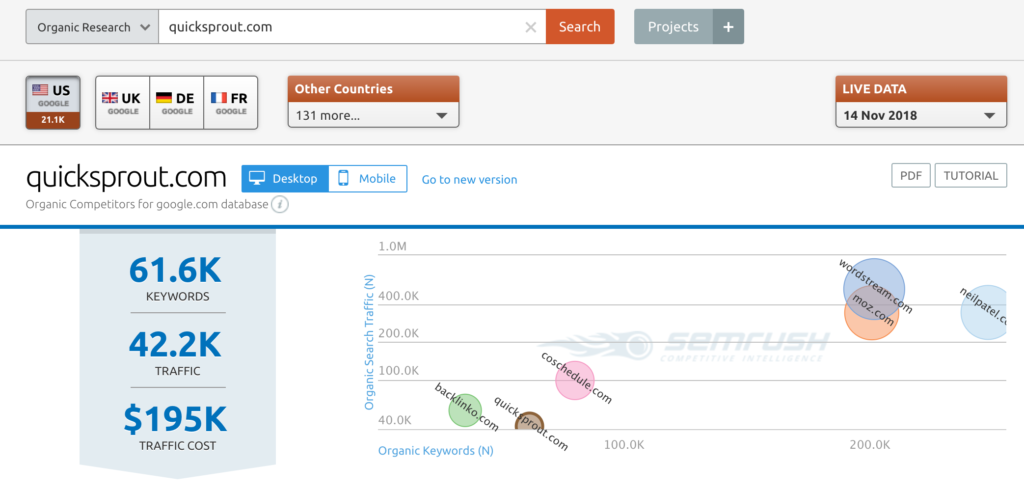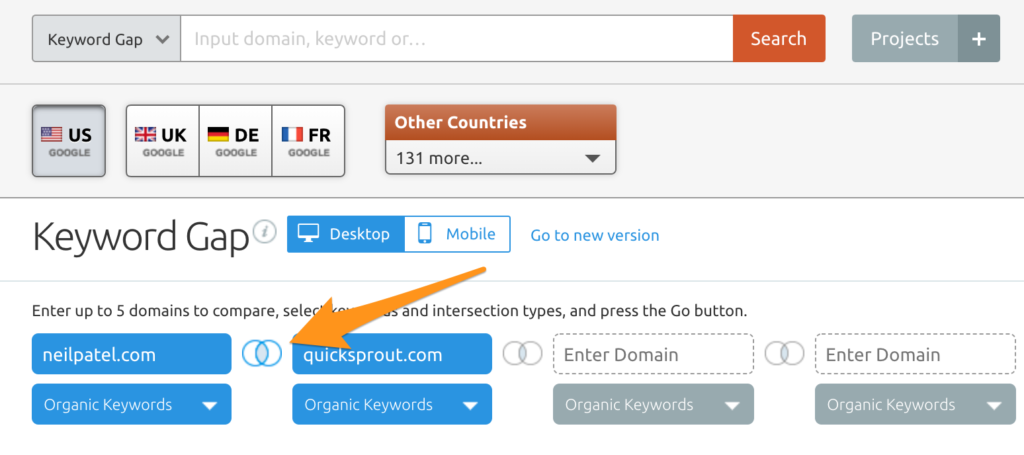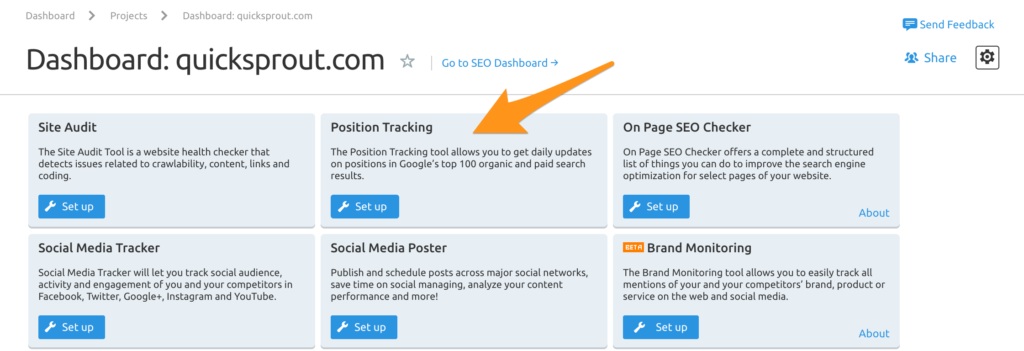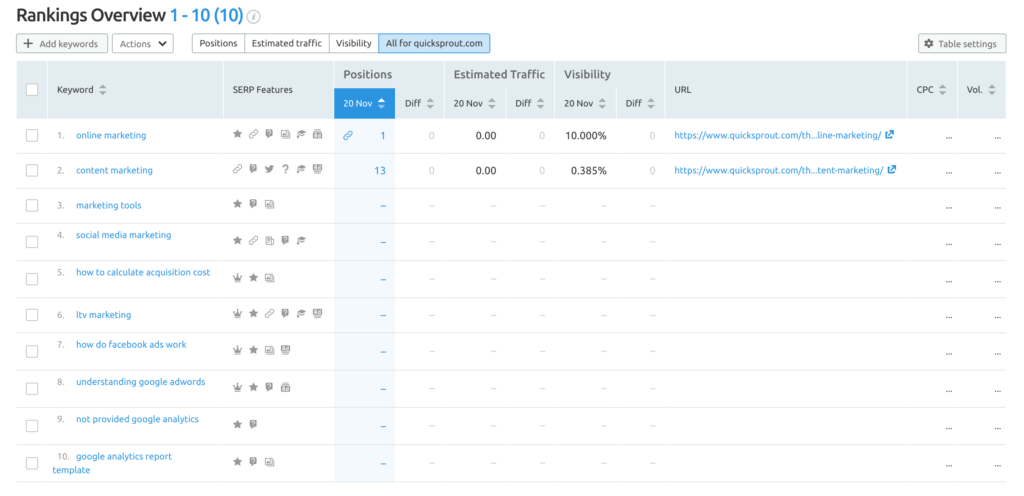How to Increase SEO Traffic in 6 Simple Steps

Want to just get started? Click here to sign up for SEMrush and increase SEO traffic today.
We used to laugh at SEO.
Dead serious.
Back when we were running the KISSmetrics blog, which grew to over 1 million visitors per month, people asked us all the time what we did for SEO.
We shrugged and said “not much.”
Then we’d chuckle at how absurd that was.
In the 2008 to 2015 period, we got away with not worrying about it.
We pushed really hard on quality and volume. Tons of quality content posted as fast as possible over a long period of time. That was our whole strategy. And it worked really, really well.
We never did keyword research. We didn’t worry about on-page SEO. We didn’t have a subscription to a single SEO tool.
Here’s the honest truth though: we were lucky.
Content marketing, SEO, and blogs were pretty new back then. We were ahead of the curve.
And when you’re ahead of the curve with a marketing channel, you can get away with being a bit sloppy. We were sloppy.
These days, the SEO game has changed.
Most of us have become jaded with content marketing, SEO, and blogs. And for good reason.
We write and write and write. Endless nights and weekends. Fast forward a year and how much has our traffic grown? Not much. It plateaus.
We talk to so many business owners and marketers that hit this same wall. We’ve hit it plenty of times ourselves.
In the last few years, we’ve completely rethought our search program. Tore it all down and rebuilt it from the ground up.
Our entire SEO program is now built around one core philosophy: go after guaranteed streams of traffic. Then stack those streams of traffic one at a time.
It’s absolutely guaranteed to grow anyone’s traffic.
So where do we find these guaranteed traffic streams? Let’s find out.
Top SEO Tools Pros Really Use to Increase SEO Traffic
If you want to increase SEO traffic, you’ll need SEO tools pros really use. Here’s the best options.
- SEMRush – Best Overall SEO Software
- Ahrefs – Best Advanced SEO Software
- Yoast – Best SEO Plugin for WordPress
- Screaming Frog – Best SEO Crawling Software
- Pitchbox – Best Outreach Software
You can read our full reviews of each SEO tool here.
6 Steps to Increase SEO Traffic
Below, we’ve outlined the 6 steps that we use to get traffic ourselves. We find the core topics that we should focus on, discover our main competitors, get our competitors to do all the work for us, and link guaranteed traffic streams for our site.
- Find your dream keyword set
- Get your competitors to do the work for you
- Build your gap keywords list
- Pick your first 10 keywords
- Build your keyword report to see when it works
- Ship 10 pieces of content
Step 1: Find Your Dream Keyword Set
First, we grab a list of keywords that we’ll consider to be our “Dream Keywords.”
In SEO-speak, these are short-tail keywords. Usually they’re 1–3 words long.
The reason that we call these “Dream Keywords” is that competition can be pretty stiff.
Let’s face it, SEO is not a new marketing strategy. Google’s now 20 years old after all.
That said, you could get lucky. We still stumble across niches that aren’t that competitive. If you’re in one of those, count your lucky stars because all the standard SEO stuff is going to work really well for you.
Most of us have to get a bit more creative in order to find guaranteed streams of traffic — that’s what the rest of the steps are for.
Even if there’s competition on our Dream Keywords, we still want to go after them. As we get wins elsewhere, our site will get stronger. As we get stronger, content targeted at our Dream Keywords will start to rank.
But we’re getting ahead of ourselves.
Right now, find the top 5 Dream Keywords in your category.
This is a bit of a judgement call, but here are some rules of thumb:
- Keep them short. They should be 1–3 words long.
- Brainstorm a list of 10–15 broad keywords that you think could describe your category. Also include major subtopics.
- Typically, one or two will be the major category and the rest will be the core subcategories.
- Use an SEO tool (like SEMrush) to check the keyword volume.
- Pick the best 5 keywords. Try to pick keywords that have the most search volume while also being a great description of your category.
- A quick word on keyword volume: Google used to include a free keyword planner with Google AdWords (now called Google Ads). They’ve begun to make their keyword estimates less accurate over time, so it’s more difficult to get good data on search volume now. These days, we recommend using an SEO keyword research tool like SEMrush.
As an example, here are the top 5 Dream Keywords that we picked for Quick Sprout:
- Online marketing
- Growth hacking
- Social media marketing
- Email marketing
- Content marketing
These don’t have to be perfect. Once you feel like they describe your category well, move on to the next step.
Step 2: Get Your Competitors to Do the Work For You
We could spend countless hours trying to brainstorm every keyword out there.
Or… we can get our competitors to give us all the answers.
This is how we find those guaranteed streams of traffic.
SEMrush has a nifty tool called the Keyword Gap Tool.
First, let’s identify all our competitors.
SEMrush happens to have a competitor report that tells us exactly who our biggest competitors are in search. In the sidebar, go to Organic Research and then Competitors. Plug in your domain at the top and you’ll get a report like this:

Very cool. In the case of Quick Sprout, the graphic shows us that neilpatel.com, wordstream.com, and moz.com are our main competitors. We also get a table of the competitors ranked:

The table includes dozens and hundreds of competitors, tons of other sites that you can exploit later. We’ll focus on the top 5 for now.
Now that we know who to focus on, it’s time to get them to do our work for us.
We’re going to go use a tool called the Keyword Gap Tool from SEMrush. It’s right in the sidebar under “Keyword Gap” if you have an account.
There’s a few things we have to configure in this report.
Once we’re done, SEMrush will tell us all the good keywords that competitors rank for and that we’re NOT ranking for yet. It’s a goldmine of traffic that we can go after.
There are a few steps to set up the report.
First, put in your competitor’s domain name into the search box at the top. This is critical. Don’t use your domain yet. You’ll get something like this:

We’ve gone ahead and entered our biggest competitor, neilpatel.com.
In the first “Enter Domain” box, enter in your domain now. Click the GO button.
At this point, the report shows us all the keywords across both domains.
This has a lot of noise though. We have keywords that we’re already winning plus a ton of junk keywords from our competitor. Too much noise to be useful.
Click on the little overlapping circles here:

Then select the “Unique to the first domain’s keywords” option. This will restrict your entire list to just the keywords your competitor ranks for that you don’t.
One more step.
To filter out the junk keywords, let’s add this filter to the report:

Set the filter to “include volume greater than 100.” This will restrict the keyword list to only keywords that get above 100 searches per month.
Here’s the final list that we get when looking at neilpatel.com:

GOLDMINE! So much traffic opportunity in this list. It’s full of topics that get consistent search volume and won’t be that competitive. Exactly what we need to grow our search traffic, guaranteed.
Here are a few gems that we could go after right away on Quick Sprout:
- how do facebook ads work
- ltv marketing
- not provided google analytics
- how to calculate acquisition cost
- All of these topics get consistent traffic and are completely greenfield traffic sources for us. You can do the exact same thing for your site.
This report sets us up perfectly for the next step.
Step 3: Build Your Gap Keywords List
Dream Keywords are usually a stretch for all of us. They’re big volume keywords that also match to our business incredibly well. That means there’s volume and high quality traffic. But valuable traffic streams usually mean competition.
To get traffic growing right away, we’re also going to look for some “Gap Keywords.” They’re also known as long-tail keywords in the SEO community.
These are keywords with competition “gaps” that we can easily exploit. Yes, the volume will be lower; so is the competition. We can rank quickly and easily, then stack a bunch of these traffic flows on top of each other. It adds up fast.
Now that we have a nifty report in SEMrush that gives us tons of Gap Keywords, it’s time to build our Gap Keyword list.
Create a list of 20 Gap Keywords. A Gap Keyword should meet these criteria:
- Be closely related to one of your Dream Keyword topics. The more authority you build in each topic, the easier it is to rank.
- A keyword between 100 and 1000 searches per month. If you have a really strong site already, feel free to go higher. If your site is brand new, stay closer to 100 searches per month if you can.
- A keyword that your site is not currently ranking for.
- Build the Gap Keywords report in SEMrush for each of your 5 major competitors, then pick 20 Gap Keywords that you’re excited about.
If you’re feeling super motivated and in the groove, feel free to build a Gap Keyword list of up to 100 keywords. That’ll give you a bank of keywords to refer to later.
Step 4: Pick Your First 10 Keywords
Quick recap, you should have all of this by now:
- 5 Dream Keywords
- Your top 5 search competitors
- 20 Gap Keywords
Out of these, we’re now going to pick 10 keywords to focus on first.
As you narrow your list down to the 10 that you’ll start with, the most important thing to keep in mind is topic authority.
For both Dream Keywords and Gap Keywords, make sure they’re within the same topical areas in Google that you’re already ranking for. You’ll rank for those types of keywords with a lot less effort since Google already trusts you in that category. You can expand into new categories if you want to, but it will take more time.
Pick 3 Dream Keywords
Pick keywords that are an ideal fit for your business. Even if they’re pretty competitive, you’ll build these over time. The goal is to start seeding content into Google that will bring extremely valuable traffic to you.
Pick 7 Gap Keywords
For these keywords, you still want them to be a good fit for your business. But pay closer attention to competition here. If lots of strong domains with tons of authority are ranking for a keyword already, save that keyword for later. Focus your Gap Keywords on niche topics that aren’t competitive.
These Gap Keywords will get your traffic growing right away, giving you more time for your Dream Keywords to gain momentum.
If you’re not sure which keywords to pick and they all have similar search volume while also being close to the main topic authority of your site, pick the keywords that you’re most excited to write about. That’ll make the rest of this more fun.
Now you have 10 keywords to focus on, 7 of which will have a much easier time ranking.
Step 5: Build Your Keyword Report to See When It Works
Once we start shipping content, we want an easier way to be able to tell how well our site is doing.
The best way to do this is with a keyword report, we recommend the SEMrush Position Tracking tool.
Start by setting up a “Project” for your domain in SEMrush. You’ll be able to do this as soon as you log in. After that you’ll get to a dashboard that includes a button to set up your Position Tracking:

You’ll have to configure a few settings, most of them are standard stuff like your domain and location.
For the competitors, use the 5 competitors that you found earlier.
And for your keywords, use the 10 keywords that you just picked.
You’ll get a report that looks like this:

In a single glance, we can see instantly how we’re ranking for all our target keywords.
Remember that since we just picked a number of Gap Keywords that we don’t rank for yet, the table will have a bunch of blank data. After we publish new content and it begins to rank, we’ll see this table fill in.
Once you start publishing content, you’ll want to check this keyword report once a month to keep an eye on how you’re doing. It makes it really easy to track your progress.
Step 6: Ship 10 Pieces of Content
Now that you have your 10 keywords, it’s time to write some content and publish it.
We recommend writing one piece of content for each of your 10 keywords.
Why 10 pieces of content?
Google can be a little finicky at times, nothing ranks with complete certainty. To compensate, we always ship content in batches. This guarantees that we’ll get some winners and increase our traffic, even if we have a few duds that Google refuses to rank for whatever reason. We need to play the odds a little bit.
Don’t worry, you don’t have to write all 10 pieces of content at once. Feel free to drip these out over time. A really good pace to set is 1 piece per week. That’s a very maintainable pace.
Of course, feel free to push harder if you have the time.
The point is to not stress about the results until you’ve gotten through all 10 pieces of content.
As you begin writing, here’s the on-page SEO tips that you’ll want to use:
- Use the keyword as the URL. For example, your URL should look like: yourdomain.com/your-keyword
- Get the keyword into the headline of the page and within an H1 tag.
- While including the keyword in the headline, try to make the headline as enticing as possible. The more enticing the headline, the more people who’ll click through to your page compared to other pages.
- Make sure there’s only one H1 tag on the page.
- Use the keyword naturally 2–3 times within the body content.
- Write at least 2000 words on the topic. This isn’t a hard requirement. The goal is to make your page more valuable than other pages that are ranking.
- Place an image on the page and use the keyword in the alt-tag of the page.
- Link to 2–3 other pages on your own site that are closely related.
- Pay close attention to search intent. Look at what other pages are ranking for that keyword to figure out what people want when they search for that keyword. Then find a way to do an even better job of giving it to them.
- Once you’ve shipped all 10, give each of them 60–90 days to settle into the Google rankings. If there isn’t much competition, you could see results as early as 30 days but don’t panic if it takes a bit longer. Google is a game of time.
With a batch of content like this, we like to see 50% of our content get on the first page of Google by day 90. That shows us that we’re on track and that our strategy is working.
As things begin to work, keep building more content around addition keywords, expanding topic by topic. You will build traffic, guaranteed.
Our Recommended SEO Tool
Hands down, we recommend SEMrush.
It’s our favorite SEO tool.
As you’ve seen, it tells you who your major competitors are in search, makes researching search volume a breeze, gives you tons of Gap Keywords for guaranteed traffic, and tracks how you’re doing on all your target keywords.
We only scratched the surface too. SEMrush automates and simplifies every SEO task out there. You get everything that you need to grow your traffic. We consider it a “must-have” tool for growing Quick Sprout.
The post How to Increase SEO Traffic in 6 Simple Steps appeared first on .